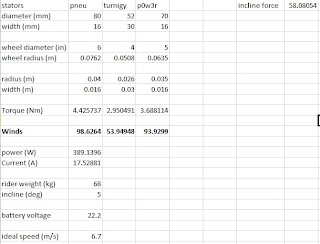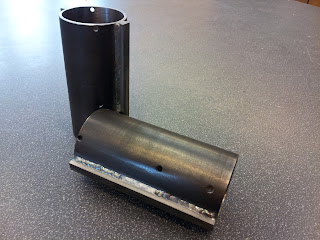A lot of time and project progress passed by. Mostly undocumented because of ME 2110: Creative Decisions and Design.
Nonetheless, Dominant Mode debuted at the
COB3 event in North Carolina this past weekend on the 14th. It placed 4th but did not disappoint when it was in optimal shape. Let's recap the final preparations and continue to describe machine performance.
With a completed frame, it was time to push together the weapon. It was composed of four main parts: the drum, the motor can, the stator mount, and the outboard endcap. I had previously intended on having Whyachi machine my drum, but after telling me they couldn't make it or it would cost me $400, I decided to pursue alternate methods.
The drum design then simplified drastically. Instead of the unibody drum, the drum became an assembly of steel bars welded to a grooved tube. There were several competition teams and ME staff that could help me weld so I would save oodles. Plus, I could machine all the parts myself on the mill, lathe, and waterjet. Hardening could be achieved through begging to Braddock Metals in Atlanta, or utilizing a kiln we dug out of a dumpster by the physics building. It was a solid plan.
4130 was selected for the drum body, and 8630 (keyway stock) was selected for the teeth. Both are chromium-molybdenum steels that anneal, harden, and temper at the same temperatures (according to the ASM materials handbook). Plus they were cheap. About $20 for the drum so far.
Some hours of machining later, I had prepped the drums and teeth. Buying 1 ft of material from Online Metals was enough to two drums. No harm in spares right?
The drums were welded together by my friend Craig Wooden. Thanks Craig!
At this point I had put off drum construction that I needed to harden it immediately or run unhardened for the event. This meant I had to use the kiln. Some experimental jiggling of the analog temperature dials found a nice ~1650 deg F of oven temperature. I weaved some magnet wire in between the drum holes for handling since copper melts at higher temperatures than 1600. I placed the drum inside the oven and let it bake for ~2 hours. Then this:
Water bath instead of oil for safety reasons. I think I may have taken too long to transport the piece from the oven to the water. It had a nice oxidation layer that cracked off from expedited rusting.
However, we still observe evidence of hardening via auditory means. A smaller hammer tapped on the side of the hardened drum produced a higher pitch ring than the unhardened one. This is indicative of a tighter packed atomic structure, or a harder material in this case.
The other parts came together as easy as cake. I turned by best piece yet and was able to keep a 1 thou tolerance on all dimensions. The magnet can was simply pressed down inside the can. Lets hope I never need to remove that piece...
... but I did.
This point shows the robot completed and playing with some objects and
Michael Jeffries' 30lber Nyx, but little did I know it was nearly a half pound overweight. I took it to the post office to weigh it the week before the event and yeah.
Massive disassembly time and uber machining mode. Each system and component was weighed to determine how much I would need to remove to make weight. Things like motors and electronics could not be changed and were simply held as a minimum weight sum. The drum weighed a whopping 26 oz with motor and all. Because steel was the densest material on the bot, it would receive the machining operation first.
The can was lightened as much as possible by turning away massive aluminum voids. The drum's teeth were castled down to the drum wall. There were some sections of the teeth that had me worried about the penetration of the welds, but this would not be the time to worry about them.
The wheels received a significant amount of attention as well. The wheels, belts, and pulleys weighed about 3.5 oz which is still a butt-ton for the beetleweights. Instead of using bronze sleeve bushings and aluminum hubs, I opted for a single piece Delrin hub. It was light, easily machined, and had semi-lubercative properties which meant I could save on bushing weight. The wheel rubber themselves were recut with some lightening holes along the radius.
Hey check it out! Tweels! I was skeptical about their impact resistance and damping effects on the robot's drive, but it worked well for the time being. Final weight for wheels, belts, and pulleys now sat at ~1.3 oz.
After replacing the metal top and bottom plates with 1/32" polycarb and garolite (so sad!) the robot tips the scale at 48.1 oz. Both mid-plate supports were removed to make weight.
The final shots.
Some nice vinyl logos and a Invention Studio temporary tattoo prepares the bot for screen time. Lets hope vinyl doesn't weigh much. I also prepared some plastic shims as anti-wedge devices. Instead of using the easily-damaged nylon, I opted for .022" thick UHMW. It seemed flexible, but hopefully not too deformable.
July 14th: Competition Day
Michael Jeffries of Near Chaos Robotics was nice enough to drive me up to North Carolina. Clash of the Bots was held at the Scheleiele Museum. A nice indoor, ventilated venue with plenty of space and power was provided. Team pit tables were predetermined and a specific table near the back door was dedicated towards charging lipoly batteries. It was very well organized. I was fortunate enough to be stationed near the arena.
As usual, I didn't take many pictures, but other people did.
Match 1: Ramvac
Without much driving practice going into this match, I was a bit nervous. I've seen this robot time and time before and Sam is without a doubt a good driver. Ramvac itself was a very sturdy wedge. It used 4 of the same modified drive motors I had so it was fast and powerful. It features a UHMW frame with hardened steel on the important parts. I knew I would not be able to go for the knockout, but I would have to use gyro dodges to my advantage to out drive him and score points.
I learned from this match that I should never never never get flipped over at all possible. The weight distribution of the robot made it very front heavy, and inverted driving was abysmal. I think I am fortunate Ramvac decided to revert my robot.
Match 2: Weta
Pete has been competing robots for quite awhile, so I expected a well polished machine. This particular robot is actually available as a kit from his website Kitbots. Conclusion: this must be a good machine. I'm not sure about the particulars on Weta anymore, since Pete mentions he was experimenting with new drive motors and a faster motor. I decide this would be an opportune time to test the max speed of my drum as well.
Let's not do that again. It appears his beater bar is in fact faster and caused me to get flipped. I spend over half the match on my head but am luckily reverted to make an astounding comback in the last 30 or so seconds. If Weta was using his old drive system, I might have been in trouble.
He dented my Ti armor :(
Inverted driving is a capital item to be addressed before Dragon Con! At least we see how effective the angled plating is in deflecting blows.
Intermission: Robot Panic
When I placed Dom into the box to face Shame Spiral, I noticed that only one drive side was responsive. The other ESC emitting the "no signal" or "out of center" error. I am forced to use my postponement to discover the error. All wires a nice and glued in (what a pain) with no connections lose. I decide to remove DDT's receiver and run the bot off two receivers, assuming the ch2 on my Spektrum Ultralite had failed. However, I eventually discovered my ch 2 on my repaired dx6i had died. Julie from Near Chaos Robotics lent me her tx for the remainder of the competition. Thanks Julie!
Match 3: Shame Spiral
A tough wedge of shock-mounted UHMW and hardened steel outer surfaces (actually harder than my expected drum hardness). I had fought Shame Spiral before at Dragon Con and was easily defeated by Thomas' driving skill and well designed deflective wedge. I hoped this time that my increased speed and anti-wedge devices would allow one good hit to invert him, where I would then leave him for the remainder of the match. I received none such luck.
Despite hits to his sides, none were able to grab and toss. As a result, I was never able to get him off the ground. Through all the abuse, my power plug (a deans micro) falls out and I tap.
Match 4: Ramvac
I was more confident this time, knowing that I had won a match against him before. However the Tx business set back the beetle brackets pretty far and I had minimal time to charge. I would have to take it easy this time and line up good shots on his sides or back.
Match 5: Grande Tambor
The expedited beetle bracket takes it toll. I had only 10 mins to charge this time, but I decided some match was better than none. This would be the ultimate test of my armor as Grande is a hard hitter and I expected a few outages during the match from undervoltage.
Every time Dom pauses is a drive esc reset. There wasn't really much I could do except wait to reconnect. I confess I believe it is a terrible way to be eliminated, but the angled armor held up well and given all issues are resolved Dom will be back for a rematch!
Well, after I fix this:
Post-competition analysis:
Clash of the Bots 3 was a tough competition with a lot of great robots. Dominant mode went 3-2, which is actually the worst record I have ever had for a new robot. No longer can I depend on the knockout win, I actually have to start buying spare batteries. I also need to investigate the control losses during the match. Its possible the battery is the issue, as in the current draw from my motors, but it could also be a need for more bus capacitance. I will have to revisit my electronics to determine the cause of these mysterious power outages.
Conclusion, Dominant Mode is a keeper! It would be nice if I could reallocate more weight to the rear of the robot such that inverted driving was more effective. I also need to make sure the pinions never disconnect from the KW motors. I will be contemplating fixes for the drum's bearing setup, but I think that hit from Grande was an exception, since I was not spinning. I will however be buying more batteries in reflection of the short charge times.
Thanks to Robert of Mad Overlord, we also have
high-speed camera footage to download for a limited time only!
I also want to thanks Mike Gellatly of Busted Nuts Robotics for helping to machine some semi-complex aluminum angle blocks for Dom's side armor.








































































